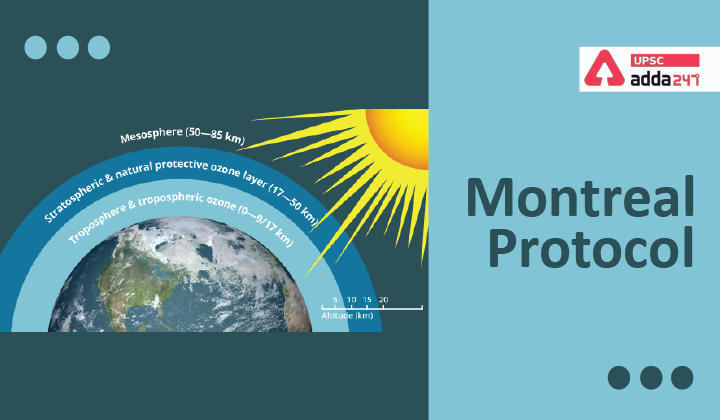Table of Contents
Montreal Protocol UPSC Relevance
- GS 3: Conservation, environmental pollution and degradation, environmental impact assessment.
What is Montreal protocol?
- The Montreal Protocol on Substances that Deplete the Ozone Layer is a global agreement to protect the Earth’s ozone layer by phasing out the chemicals that deplete it.
- This phase-out plan includes both the production and consumption of ozone-depleting substances.
- The landmark agreement was signed in 1987 and entered into force in 1989.
Montreal protocol History
- By 1985, due to scientific advancements, ozone depletion and its impacts on human health and the environment became evident.
- It was then that the Vienna Convention for the Protection of the Ozone Layer was created in response.
- The Vienna Convention was the first convention of any kind to be signed by every country involved, taking effect in 1988 and reaching universal ratification in 2009.
- The Convention aimed to promote cooperation among nations by exchanging information on the effects of human activities on the ozone layer.
- Vienna convention, however, does not require countries to take control actions to protect the ozone layer as the convention is not legally binding.
- To address this issue, later came the Montreal protocol.

Montreal Protocol Key Points
- The Montreal Protocol is signed by 197 countries.
- It is the first treaty in the history of the United Nations to achieve universal ratification.
- It is also considered by many experts as the most successful environmental global action.
- Montreal Protocol regulates the production and consumption of nearly 100 man-made chemicals referred to as ozone depleting substances (ODS).
- When released to the atmosphere, those chemicals damage the stratospheric ozone layer.
- Common But Differentiated Responsibilities (CBDR): The Montreal Protocol phases down the consumption and production of the different ODS in a step-wise manner, with different timetables for developed and developing countries.
- Though both developing and developed countries have equal but differentiated responsibilities, but most importantly, both groups of countries have binding, time-targeted and measurable commitments.
- The protocol is assisted by the Ozone Secretariat, which is based at UN Environment Programme headquarters in Nairobi, Kenya.
Montreal Protocol provisions
Below are some of the important provisions of the Montreal Protocol.
- Control Measures (Article 2),
- Calculation of control levels (Article 3),
- Control of trade with non-Parties (Article 4),
- Special situation of developing countries (Article 5).

Substances controlled under Montreal Protocol
- Annexes A (CFCs, halons),
- Annexes B (other fully halogenated CFCs, carbon tetrachloride, methyl chloroform),
- Annexes C (HCFCs),
- Annexes E (methyl bromide) and
- Annexes F (HFCs).
Multilateral Fund of Montreal Protocol
- The Multilateral Fund was established in 1991 for the implementation of the Montreal Protocol.
- The Fund’s objective is to provide financial and technical assistance to developing countries whose annual per capita consumption and production of ODS is less than 0.3 kg.
- The Multilateral Fund’s activities are implemented by four international agencies – UN Environment Programme (UNEP), UN Development Programme (UNDP), UN Industrial Development Organisation (UNIDO) and the World Bank – as well as bilateral agencies of non-Article 5 countries.
Phase out of HCFCs – the Montreal Amendment
- Hydrochlorofluorocarbons (HCFCs) are gases used worldwide in refrigeration, air-conditioning and foam applications, but they are being phased out under the Montreal Protocol since deplete the ozone layer.
- HCFCs are both ODS and powerful greenhouse gases: the most commonly used HCFC is nearly 2,000 times more potent than carbon dioxide in terms of its global warming potential (GWP).
- In September 2007, the Parties decided to accelerate their schedule to phase out HCFCs.
- Developed countries were scheduled to completely phase them out by 2020.
- Developing countries agreed to start their phase out process in 2013 and are now following a stepwise reduction until the complete phase-out of HCFCs by 2030.
Phase down of HFCs – the Kigali Amendment
- Click here to read about this in detail.
Success of Montreal Protocol
- With the full and sustained implementation of the Montreal Protocol, the ozone layer is projected to recover by the middle of this century.
- Without this treaty, ozone depletion would have increased tenfold by 2050 compared to current levels, and resulted in millions of additional cases of melanoma, other cancers and eye cataracts.
- It has been estimated, for example, that the Montreal Protocol is saving an estimated two million people each year by 2030 from skin cancer.
- To date, the Parties to the Protocol have phased out 98% of ODS globally compared to 1990 levels.
- Because most of these substances are potent greenhouse gases, the Montreal Protocol is also contributing significantly to the protection of the global climate system.
- Under the Kigali Amendment, actions to limit the use of HFCs under the Montreal Protocol is expected to prevent the emissions of up to 105 million tonnes of carbon dioxide equivalent of greenhouse gases.
- It is expected to help in avoiding up to 0.5 degree Celsius of global temperature rise by 2100.
- It has also helped in achieving the commitments under Paris Agreement.
- The Montreal Protocol also makes important contributions to the realization of the UN Sustainable Development Goals.
Montreal Protocol Revision
| The Montreal protocol is related to | Ozone depletion |
| Montreal protocol was signed in | 1987 |
| Montreal protocol is associated with | Ozone Depleting Substances |
| Montreal protocol year | Signed- 1987, came in effect- 1989 |
| Montreal protocol India | India India became Party to the Vienna Convention and the Montreal Protocol on 18th March, 1991 and 19th June 1992 respectively. |
Also Read:
| World Trade Organisation (WTO) | India Loses WTO Dispute over Sugar Subsidies | National Leprosy Eradication Programme | Coal Controller Organisation |
| Green Day Ahead Market | World Energy Outlook 2021 | 44th Constitutional Amendment Act | One Commodity One Exchange’ Policy |
| India International Science Festival (IISF) | Gaganyaan Space Mission | The Upcoming Crisis in Indian Federalism | Protests In Cuba And The Cuban Crisis |



 TSPSC Group 1 Question Paper 2024, Downl...
TSPSC Group 1 Question Paper 2024, Downl...
 TSPSC Group 1 Answer key 2024 Out, Downl...
TSPSC Group 1 Answer key 2024 Out, Downl...
 UPSC Prelims 2024 Question Paper, Downlo...
UPSC Prelims 2024 Question Paper, Downlo...
